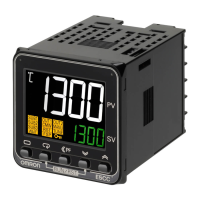How to check for programming errors in host device for Omron E5CC?
- RRachel OdonnellSep 23, 2025
If there is a mistake in programming in the host device, use a line monitor to check the commands.






How to check for programming errors in host device for Omron E5CC?
If there is a mistake in programming in the host device, use a line monitor to check the commands.
How to fix a large temperature error (S.Err display) on my Omron E5CC Temperature Controller?
A large temperature error or an input error (S.Err display) on your Omron Temperature Controller can be caused by an input type mismatch. Check the sensor type and reset the input type correctly. It can also be caused by the thermometer not being installed properly. Check the thermometer installation location and polarity and install correctly.
How to prevent Omron E5CC communication data corruption due to environmental noise?
If the communications data is being corrupted by noise, try using a slower baud rate. Also, separate the communications cable from the source of the noise.
Why can't I always change set points on my Omron E5CC?
If it's sometimes not possible to change the set points or RUN/STOP status on your Omron Temperature Controller, there may be noise interference. Connect terminating resistance to both ends of the communications line.
How to stabilize Omron E5CC Temperature Controller communication line after power interruption?
If the communications line became unstable when the Controller’s power was turned ON or interrupted, initialize the reception buffer in the host device before sending the first command.
What to do if the host device sends another command before receiving a response from the Omron E5CC Temperature Controller?
If the host device sent another command before receiving a response from the Controller, always read the response after sending a command.
How to set an end node for Omron E5CC Temperature Controller communication line?
If an end node has not been set at each end of the communications line on your Omron Temperature Controller, set or connect terminating resistance at each end of the line.
What to do if the Omron E5CC isn't receiving the specified power supply voltage?
If the specified power supply voltage is not being supplied to the Controller, supply the specified power supply voltage.
What to do if the Omron E5CC Temperature Controller communication cable is broken?
If the communications cable is broken on your Omron Temperature Controller, replace the cable.
What to do if the Omron Temperature Controller communication line is disconnected?
If the communications line has become disconnected on your Omron Temperature Controller, connect the communications line securely and tighten the screws.
| Number of Display Digits | 4 digits |
|---|---|
| Number of Control Outputs | 1 |
| Control Method | ON/OFF |
| Input Type | Thermocouple, RTD, Analog voltage, Analog current |
| Supply Voltage | 100 to 240 VAC |
| Output Type | Relay, Voltage, Current |
| Display Type | LCD |
| Size | 48 x 48 mm |
| Mounting Method | Panel mount |
| Control Output | Relay, Voltage, Current |
| Alarm Output | Relay |
| Communication | RS-485 |
| Ambient Operating Temperature | -10 to 55°C |
| Ambient Operating Humidity | 25% to 85% RH |
| Protection Rating | IP66 |
Covers all aspects of physical installation, including dimensions and mounting.
Detailed guide on connecting wires to the terminal blocks for various models.
Details how to configure the controller for different sensor inputs.
Methods for calculating or setting PID control constants.
Configuration of alarms using auxiliary outputs or control outputs.
Setting up and performing heating and cooling control operations.
Securing the controller settings by restricting access via front panel keys.
Detecting errors in the control loop, such as when the heater fails.
Procedures for manually controlling the process variable.
Details the four levels of protection for parameters and key operations.
Parameters for PID control, tuning, and heating/cooling adjustments.
Basic setup parameters including input type, units, and control methods.
Parameters for advanced features like logic operations, alarms, and tuning.
Lists potential error codes and their meanings and remedies.